2. 中国地质大学地球科学与资源学院, 北京 100083
2. School of Earth Sciences and Resources, China University of Geosciences, Beijing 100083, China
喜马拉雅造山带是印度与亚洲大陆碰撞作用的产物,是世界上最年轻且仍在进行的陆-陆碰撞造山带,是建立造山作用理论和造山带构造演化模型的天然实验室(Yin and Harrison, 2000)。喜马拉雅造山带核部由高喜马拉雅结晶岩系组成(图 1),其是深俯冲后又折返上来的印度大陆地壳,记录了碰撞造山作用过程中发生的变质、变形与深熔作用历史(Pêcher, 1989; Pognante and Benna, 1993; Goscombe and Hand, 2000; Ding et al., 2001, 2016a, b; Cottle et al., 2009; Streule et al., 2010; Zhang et al., 2010, 2015, 2017; Zeng et al., 2011, 2012; Rubatto et al., 2013; Wang et al., 2013, 2015a, b, 2016; 张泽明等, 2013; Kohn, 2014),是研究喜马拉雅造山带形成与演化的关键。
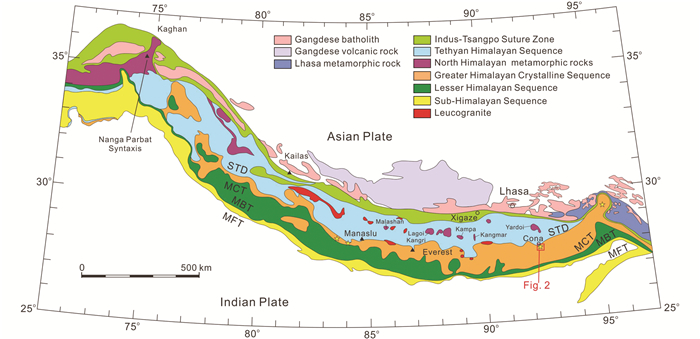
|
图 1 青藏高原地质简图(据Yin and Harrison, 2000修改) Fig. 1 Simplified geological map of the Himalayan orogen (modified after Yin and Harrison, 2000) |
尽管现今对高喜马拉雅结晶岩系进行了许多研究,取得了很多重要进展,但仍有一些问题存有争议。相关的问题包括:(1) 高喜马拉雅结晶岩系的变质作用程度。有学者认为其经历了中压角闪岩相-麻粒岩相变质作用(Searle et al., 2003, 2006; Kohn, 2008; Yakymchuk and Godin, 2012; Rubatto et al., 2013; Sorcar et al., 2014; Ding et al., 2016a, b),有人认为其经历了高压麻粒岩相变质作用(Liu and Zhong, 1997; Ding and Zhong, 1999; Zhang et al., 2010, 2015, 2017; 李旺超等, 2015),也有人认为其经历了榴辉岩相变质作用(Groppo et al., 2007; Corrie et al., 2010; Kali et al., 2010; Wang et al., 2017a);(2) 高喜马拉雅结晶岩系的变质作用持续时间。先前的研究多认为高喜马拉雅结晶岩系的变质演化包括始喜马拉雅(Eohimalayan, 38~32Ma)和新喜马拉雅(Neohimalayan, 26~18Ma)两个阶段(Hodges et al., 1988; Pêcher, 1989; Simpson et al., 2000)。这种认识以及后来的研究都表明高喜马拉雅结晶岩系普遍经历了一个长期持续的变质作用过程(如,>30Myr; Zhang et al., 2015; Ding et al., 2016b);但也有研究认为,高喜马拉雅结晶岩系或其部分岩片具有较短的变质作用持续时间(如, ~10Myr, Simpson et al., 2000; ~4Myr, Ambrose et al., 2015);(3) 高喜马拉雅结晶岩系是否整体经历过深熔作用。有研究认为代表高喜马拉雅结晶岩系上部构造层位的北喜马拉雅片麻岩穹隆(雅拉香波和麻布加穹隆)经历了角闪岩相-麻粒岩相的变质和深熔作用(Lee et al., 2004; Lee and Whitehouse, 2007; 高利娥, 2010),而Ding et al.(2016a, b)则认为穹隆核部的变质岩没有发生过部分熔融。此外,关于深熔作用的机制与方式也存在争议,如深熔作用是发生在大陆俯冲-地壳加厚过程中(Guilmette et al., 2011; Groppo et al., 2012),还是发生在折返过程中(Patiño Douce and Harris, 1998),是白云母和黑云母脱水熔融(Harris and Massey, 1994; Cottle et al., 2009; Zhang et al., 2015, 2017),还是注水熔融(King et al., 2011; Zeng et al., 2012);(4) 高喜马拉雅结晶岩系是内部均匀的,还是存在明显的构造变质不连续。越来越多的研究表明,造山带中段高喜马拉雅结晶岩系内部广泛存在构造不连续现象(Vannay and Hodges, 1996; Godin et al., 2001; Groppo et al., 2009; Montomoli et al., 2013, 2015; Ambrose et al., 2015; Wang et al., 2015a, 2016),但这些不连续能否沿造山带走向延伸还需要研究。
本文选择造山带东段错那地区高喜马拉雅结晶岩系中的正片麻岩进行了岩石学、锆石与独居石U-Pb年代学以及相平衡模拟研究。研究揭示,这些片麻岩具有早古生代的原岩年龄,经历了渐新世的高角闪岩相变质作用和部分熔融,并显示出碰撞造山带的典型变质作用特征。本研究不仅揭示高喜马拉雅岩系的部分熔融发生在大陆俯冲与地壳加厚过程中,还表明研究区的高喜马拉雅结晶岩系较上部构造层位并无构造变质不连续现象。这些认识为喜马拉雅造山带构造模型的建立提供了重要限定。
2 地质背景印度与亚洲大陆在新生代碰撞形成了喜马拉雅造山带。整个造山带长约2500km,呈弧形展布,由4个岩石-构造单元组成,从北到南依次为:特提斯喜马拉雅岩系、高喜马拉雅结晶岩系、低喜马拉雅岩系和次喜马拉雅单元(前陆盆地)。它们之间的界限分别为藏南拆离系(STD)、主中央逆冲断裂(MCT)和主边界逆冲断裂(MBT)(图 1; Hodges, 2000; Yin and Harrison, 2000)。
高喜马拉雅结晶岩系由一套原岩年龄为新元古代-古生代的变质表壳岩和变质岩浆岩组成(Le Fort, 1975; Hodges, 2000; Searle and Godin, 2003; Ding and Zhang, 2016; Wang et al., 2017b)。根据岩石组成,可以将该岩系划分为3个岩石构造单元,最下部主要由含蓝晶石的变沉积岩、混合岩以及少量石英岩、钙硅酸盐岩和大理岩组成。中部主要由钙硅酸盐岩、大理岩和少量变质泥质和砂质岩石组成。上部主要由正片麻岩与少量含蓝晶石或夕线石的混合岩组成。此外,在中上部单元广泛分布有中新世的淡色花岗岩(Visonà et al., 2012; Guo and Wilson, 2012)。
本文所研究的高喜马拉雅结晶岩系分布于错那南部(图 2),主要由正片麻岩及少量片岩、副片麻岩和斜长角闪岩组成,普遍具有混合岩化特征,含有条带状产出的浅色体。正片麻岩的原岩年龄为新元古代(Ding and Zhang, 2016)和早古生代(见后文)。岩石组合和产出的构造部位都表明,研究区相当于高喜马拉雅结晶岩系的上部构造单元。所研究的正片麻岩沿近南北向的公路采集,三组样品分布距离约18km。最北部的一组样品以北约1.5km即为藏南拆离系(STD)。STD之上为低绿片岩相变质的特提斯喜马拉雅岩系(THS),其由千枚岩、板岩和变质砂岩组成。这表明STD上、下存在明显的变质作用差异,即存在明显的岩石构造单元缺失。
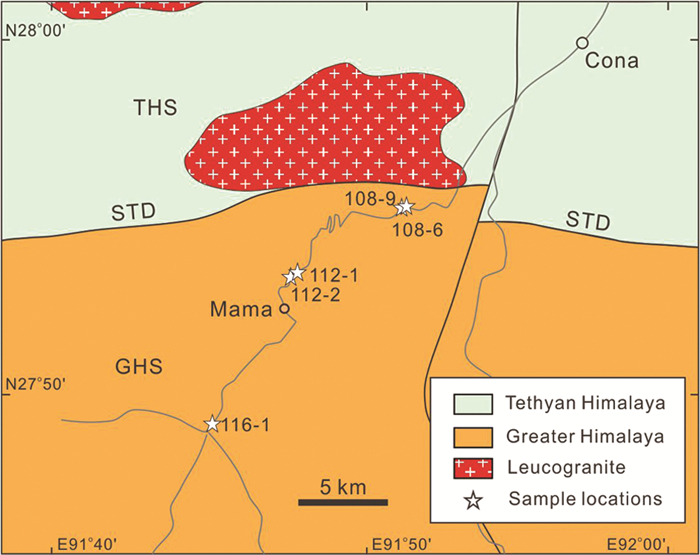
|
图 2 错那地区地质简图 Fig. 2 Geological map of the Cona area |
全岩化学成分分析在国家地质实验测试中心完成。主量元素分析采用X-ray荧光光谱法(Rigaku-3080),分析精度优于0.5%。矿物化学成分在中国地质科学院地质研究所使用JEOL JXA8900电子探针分析。分析条件是15kV加速电压,电子速电流为5nA,电子束斑为5μm。
锆石和独居石U-Th-Pb同位素定年在武汉上谱分析实验室完成。测试仪器为LA-ICP-MS,激光剥蚀系统为GeoLas 2005,ICP-MS为Agilent 7700。激光剥蚀斑束直径为24μm和10μm。在锆石U-Pb同位素定年实验操作过程中,标样采用91500和GJ-1,其中内标GJ-1的平均值为603.4±2.0Ma(2σ, n=14),与推荐值(602.1±4.9Ma, Liu et al., 2010a; 599.8±1.7Ma, Jackson et al., 2004)一致。在独居石U-Th-Pb同位素定年实验操作过程中,标准独居石44069为外标,标准独居石TRE为内标,其实验测试的平均值为274.3±1.0Ma(2σ, n=16),与推荐值(272Ma)一致。其微量元素矫正外标均采用SRM610,锆石微量元素矫正内标为29Si,而独居石采用多外标无内标的矫正方法,归一化元素为Ce。对分析数据的离线处理采用软件ICPMSDataCal完成。详细的仪器操作条件见Liu et al. (2010b),同位素数据结果处理使用ISOPLOT软件(Ludwig, 2003)完成。
此外,因独居石富含Th元素,过量的206Pb常导致U-Pb年龄被过高估计。但是所研究样品的独居石U-Pb年龄和Th-Pb年龄没有明显差异,在误差范围内一致,而且U-Pb年龄和Th/U比值之间没有相关关系(见后文)。此外,研究也表明喜马拉雅造山带变质岩石中的过剩206Pb不明显,并且具有相似的U-Pb年龄和Th-Pb年龄(Martin et al., 2007; Rubatto et al., 2013; Stearns et al., 2013; Larson and Cottle, 2014)。因此,对所研究的样品来说,其Th-Pb和U-Pb年龄都是可信的,而本文选择报道了U-Pb年龄。
4 岩石学所研究的5个样品均为含石榴石片麻岩,它们具有相似的结构、构造特征和矿物组成。岩石具片麻状和条带状构造,由长英质浅色体和富铁镁矿物的暗色体相间组成,并多发育露头尺度的褶皱变形。含石榴石片麻岩样品108-9具斑状变晶结构,变斑晶石榴石为自形-半自形,2.0~3.0mm,变基质矿物为斜长石、钾长石、石英、黑云母以及少量白云母和钛铁矿(图 3a)。石榴石中富含单相和多相包体,单相包体为石英或钛铁矿,多相包体由石英+斜长石+钾长石+黑云母组成,或仅由石英+白云母或石英+斜长石组成(图 3a)。这些多相包体很可能是由早期的熔体包体结晶形成。有些钾长石变斑晶边缘呈港湾状,被斜长石和蠕虫状石英组成的蠕英石替代(图 3b)。样品108-6具斑状变晶结构,他形的石榴石为变斑晶,基质为斜长石、石英、黑云母以及少量钾长石、白云母和钛铁矿(图 3c)。石榴石核部含斜长石、黑云母和钛铁矿包体(图 3c)。基质中可见由斜长石和石英组成的蠕英结构。样品112-2由斜长石、钾长石、石英、黑云母、石榴石以及少量白云母和钛铁矿组成(图 3d)。石榴石呈不规则状残留体分布在由斜长石和黑云母组成的合晶中,是石榴石与熔体反应的结果(图 3d)。该样品也可见少量斜长石包含蠕虫状石英。
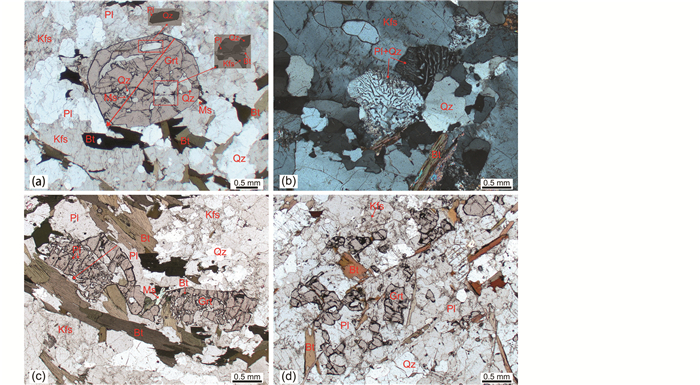
|
图 3 错那地区正片麻岩显微照片 (a)样品108-9,主要由石榴石、斜长石、钾长石、石英、黑云母以及少量白云母和钛铁矿组成.石榴石中富含单相和多相包体,单相包体为石英或钛铁矿.多相包体为石英+斜长石+钾长石+黑云母、石英+白云母和石英+斜长石;(b)样品108-9,钾长石变斑晶被斜长石和石英构成的蠕英石交代;(c)样品108-6,主要由石榴石、斜长石、石英、黑云母以及少量钾长石、白云母和钛铁矿组成.石榴石核部含斜长石、黑云母和钛铁矿单相包体;(d)样品112-2,由斜长石、钾长石、石英、黑云母、石榴石以及少量白云母和钛铁矿组成.石榴石呈不规则状残留,被斜长石和黑云母替代.本文所采用的矿物代号:Alm-铁铝榴石;Bt-黑云母;Crd-堇青石;Grs-钙铝榴石;Gt-石榴石;Ilm-钛铁矿;Kfs-钾长石;Ky-蓝晶石;Ms-白云母;Pl-斜长石;Prp-镁铝榴石;Qz-石英;Rt-金红石;Sil-夕线石;Spe-锰铝榴石;Spe-榍石;St-十字石;Zo-黝帘石;Liq-熔体 Fig. 3 Microphotographs of the Cona orthogneiss |
基于岩相学观察,所研究的石榴石片麻岩具有相同的峰期矿物组合,即石榴石+斜长石+钾长石+黑云母+白云母+石英+钛铁矿+熔体。在部分岩石中的峰期矿物,如石榴石与熔体反应形成了晚期的斜长石和黑云母。多相矿物包体、蠕英结构和矿物-熔体回反应结构的存在,表明岩石经历了部分熔融,并且有残留熔体存在。
对3个相平衡模拟的样品中的矿物化学成分进行了探针分析。样品108-9中的石榴石变斑晶具有明显的成分环带,其镁铝、钙铝、铁铝和锰铝榴石组分分别为0.03~0.06、0.10~0.29、0.55~0.67和0.10~0.25(图 4、图 5a、表 1)。石榴石核部具有最高的钙铝榴石组分,并且从幔部至边部明显降低。镁铝和铁铝榴石组分从核部至幔部增加,为进变质生长环带,而至边部减少,是扩散作用的结果(Spear et al., 1990)。锰铝榴石组分从核部到幔部有弱的增加趋势,至边部明显增高,显示出扩散成分环带的特征。样品108-6中的石榴石具有一个成分较均匀的核部,但其边部的镁铝和铁铝榴石组分降低,锰铝榴石组分增加(图 5b、表 1)。镁铝、钙铝、铁铝和锰铝榴石组分分别为0.05~0.07、0.08~0.10、0.62~0.66和0.18~0.24(表 1)。样品112-2中的石榴石具有较小的粒度,成分较均匀,其镁铝、钙铝、铁铝和锰铝榴石组分分别为0.08~0.11、0.04~0.05、0.76~0.78和0.08~0.11(表 1)。

|
图 4 样品108-9石榴石变斑晶X光成分扫描图 Fig. 4 X-ray mapping of garnet from Sample 108-9 |

|
图 5 错那地区正片麻岩石榴石成分剖面图 Fig. 5 Garnet compositional profiles from Cona orthogneiss |
|
|
表 1 石榴石化学成分表(wt%) Table 1 Garnet chemical compositions (wt%) |
3个样品中的基质斜长石具有较低的CaO含量(3.09%~6.45%),而石榴石中的包体斜长石具有较高的CaO含量(6.02%~7.36%)。样品108-9和108-6中的基质斜长石为更长石或中长石(An=0.20~0.32)。样品112-2中的基质斜长石为更长石(An=0.27)。样品108-9和108-6中的包体斜长石为更长石或中长石,钙长石组分分别为An=0.29~0.31和An=0.33~0.36。样品108-9和108-6中的基质钾长石和石榴石中的包体钾长石成分较一致,其Or=0.85~0.91。样品112-2中的基质钾长石成分变化稍大,Or=0.75~0.92(表 2)。样品108-9中的基质黑云母具有较高的TiO2含量(2.32%~2.75%;XTi=0.14~0.16) 和低的XMg(0.27)。而其它2个样品(108-6和112-2) 中的黑云母具有较低的TiO2含量(1.86%~2.23%和0.87%~1.67%;XTi=0.11~0.13和0.05~0.10) 和较高的XMg(0.30~0.31和0.36~0.37)。样品108-6中的包体黑云母具有与基质黑云母相似的TiO2含量(2.34%;XTi=0.14) 和XMg(0.31) 值(表 3)。样品108-6中的基质白云母的SiO2含量为47.63%(Si=3.203;表 3)。
|
|
表 2 斜长石和钾长石化学成分表(wt%) Table 2 Plagioclase and K-feldspar chemical compositions (wt%) |
|
|
表 3 黑云母和白云母化学成分表(wt%) Table 3 Biotite and muscovite chemical compositions (wt%) |
对变质岩石温、压条件的估计,以前的研究多采用传统地质温压计方法(Wu and Chen, 2015)。近年来,越来越多的学者开始使用相平衡模拟方法。它不仅可以定量地模拟实际全岩化学成分体系下变质岩石的变质和熔融反应发生的温压条件与过程,还可以定量地模拟矿物和熔体的含量与成分。
本文相平衡模拟使用Perple_X程序(Connolly, 2016年升级的6.7.4版)。所涉及的矿物及熔体相的活度-成分关系模型为Holland and Powell (1998)的升级版。考虑到P2O5主要赋存于磷灰石中,且在所研究岩石中含量很低,因此被忽略。所研究岩石中石榴石及钛铁矿中Fe3+含量可忽略,因此假设Fe均为Fe2+。相平衡模拟选择的成分体系为MnO-Na2O-CaO-K2O-FeO-MgO-Al2O3-SiO2-H2O-TiO2-O2(MnNCKFMASHTO)。模拟采用实测全岩成分(表 4)。
|
|
表 4 错那地区正片麻岩全岩化学成分表(wt%) Table 4 Whole-rock compositions of the Cona orthogneiss (wt%) |
对于样品108-9,在计算的4~13kbar和450~800℃区间内(图 6a, b),石榴石、斜长石和黑云母稳定存在,白云母稳定在<760℃的区域,体系的固相线位于680~700℃之间。所研究岩石的变质条件首先是看矿物组合在视剖面图中稳定域的温、压条件。模拟结果表明,所观察到的峰期矿物组合Grt+Pl+Kfs+Bt+Ms+Qz+Ilm+melt稳定在6.0~11.0kbar和685~735℃的范围内(图 6a)。此外,矿物等值线,如石榴石XPrp和XGrs、黑云母XTi以及斜长石An值,可以用来进一步限定所研究岩石的变质温、压条件。如上文所述,石榴石中的Ca具生长环带,而石榴石边部的Mg受到扩散改造。石榴石的边部XGrs(0.10~0.13),基质斜长石较低的An(0.20和0.22) 和黑云母XTi(0.14~0.16) 均通过峰期矿物组合稳定区域。其中石榴石边部最低的XGrs=0.10,斜长石最低的An=0.20和黑云母最高的XTi=0.16相交所给出的温、压条件为10.5kbar和730℃(图 6a, b,红色填充圈)。具有最低An的斜长石、最高XTi的黑云母及最低XGrs的石榴石边部很可能是峰期变质阶段的共生矿物,它们相交给出的温、压条件应该代表岩石的峰期变质条件,相对应的熔体含量约为3%。如前文所述,该样品石榴石核部和幔部的Mg和Ca呈现生长环带特征,因此,相应成分等值线相交可以限定岩石的进变质条件。石榴石核部的XPrp(0.03~0.04) 和XGrs(0.27~0.29) 等值线相交限定的温、压条件为7.0~7.5kbar和510~530℃(图 6b,黄色填充小圈)。石榴石幔部XPrp(0.04~0.06) 和XGrs(0.16~0.23) 等值线相交于较高的温、压条件,为7.5~8.5kbar和570~620℃的区域(图 6b,橘色填充小圈)。

|
图 6 错那地区正片麻岩P-T视剖面图 (a、b)样品108-9;(c、d)样品108-6;(e、f)样品112-2.红色和黄色虚线为分别为熔体和石榴石含量等值线;绿色虚线和洋红细实线分别为石榴石XPrp和XGrs等值线;蓝色和黑色细虚线分别为斜长石An和黑云母Ti等值线;红色小圈代表峰期变质条件;黄色和棕色填充圈分别为石榴石核部和幔部的XPrp和XGrs等值线交点;带箭头的蓝色粗实线和虚线分别代表进变质和退变质P-T轨迹;红色粗实线为体系的固相线 Fig. 6 P-T pseudosections for the Cona orthogneiss |
对于样品108-6,在计算的4~13kbar和500~850℃范围内,石榴石、斜长石和黑云母稳定存在(图 6c, d),白云母稳定在<750℃的区域,体系的固相线位于680~700℃之间。所观察到的峰期矿物组合Grt+Pl+Kfs+Bt+Ms+Qz+Ilm+melt稳定在7.0~10.0kbar和690~720℃区域(图 6c)。由于除石榴石的钙铝榴石组分外,其他三个端元组分均受到扩散作用改造,所以仅有石榴石边部的XGrs等值线可以限定岩石的峰期变质条件。石榴石边部的XGrs(0.08~0.10)、基质斜长石较低的An(0.28) 以及黑云母较高的XTi(0.14) 通过了峰期矿物组合稳定域。其中,石榴石XGrs=0.10与基质斜长石中最低的An=0.28相交于峰期变质矿物组合稳定域边缘,所限定的P-T条件为约9.5kbar和710~720℃(图 6c, d,红色填充圈)。如上文所述,具有最低An的斜长石和较低XGrs的石榴石,很可能是峰期变质条件下的矿物。因此,它们的交点所给出的温、压条件很可能代表岩石峰期的变质温、压条件,相对应的熔体含量约3%。
对样品112-2,在计算的4~13kbar和500~850℃范围内,石榴石、斜长石和黑云母稳定存在(图 6e, f),白云母稳定在<780℃的区域,体系的固相线位于690~705℃之间。所观察到的矿物组合Grt+Pl+Kfs+Bt+Ms+Qz+Ilm+melt稳定在一个较小的区域内,其温、压条件为9.0~9.5kbar和740~750℃,并且石榴石XGrs(0.05) 等值线也通过了该区域(图 6e, f)。所以,这一条件应该代表岩石的峰期变质温、压条件,对应的熔体含量为2%~3%(图 6e)。
相平衡模拟结果表明,所研究的3个片麻岩样品具有类似的峰期变质条件和部分熔融程度,其温、压范围是9.0~10.5kbar和710~750℃,相当于高角闪岩相变质条件,熔体含量约为2%~3%。样品108-9中石榴石核部和幔部给出了较低的进变质条件(分别为7.0~7.5kbar和510~530℃与7.5~8.5kbar和570~620℃)。联结样品的进变质与峰期变质条件,可以获得一个具增温、增压特征的进变质作用P-T轨迹(图 6b带箭头的蓝色粗实线)。
由于所研究的片麻岩中均含有少量白云母,并且与其它矿物稳定共生,所以岩石的峰变质条件和退变质轨迹都应该在白云母稳定域内,其退变质轨迹不可能是升温降压过程。考虑到高喜马拉雅结晶岩系的早期退变质多为近等温降压或弱增温降压过程(Rubatto et al., 2013; Iaccarino et al., 2015; Zhang et al., 2015, 2017; 图 7),我们推测岩石的退变质P-T轨迹很可能具有弱降温和显著降压的特征(图 6b, d, f带箭头的蓝色粗虚线)。所研究的3个片麻岩可能具有类似的顺时针P-T轨迹,以早期升温、升压进变质和晚期降温、降压退变质过程为特征(图 7)。

|
图 7 错那地区正片麻岩变质作用P-T-t轨迹 红色细线为所研究岩石的固相线;图中数字为年龄(Ma);变质相边界修改自Vernon and Clarke (2008) Fig. 7 Metamorphic P-T-t paths of the Cona orthogneiss |
对5个片麻岩中的锆石和独居石进行了U-Pb定年和微量元素原位分析,分析结果见电子版附表 1和附表 2。这些片麻岩样品中的锆石特征相似,无色、半自形-自形柱状,粒度约100~200μm。阴极发光图像显示锆石具有核-边结构(图 8)。锆石核部多为长柱状,具较清晰的震荡环带(图 8),较高且变化的Th/U值(0.009~2.624,附表 1),较高的REE含量,轻、重稀土明显分馏和负Eu异常的REE模式(图 9f-j)。而锆石边部发光性弱,无环带或具有弱的补丁状环带(图 8),具有较低的Th/U值(0.002~0.048,附表 1)和低的REE含量,轻、重稀土分馏相对较弱及负Eu异常的REE模式(图 9f-j)。
|
|
附表 1 锆石U-Pb定年和稀土元素(×10-6)分析结果 AppendixTable1 Zircon U-Pb dating data and rare earth element compositions (×10-6) |
|
|
附表 2 独居石U-Pb定年和微量元素(×10-6)分析结果 AppendixTable2 Monazite U-Pb dating data and trace element compositions (×10-6) |
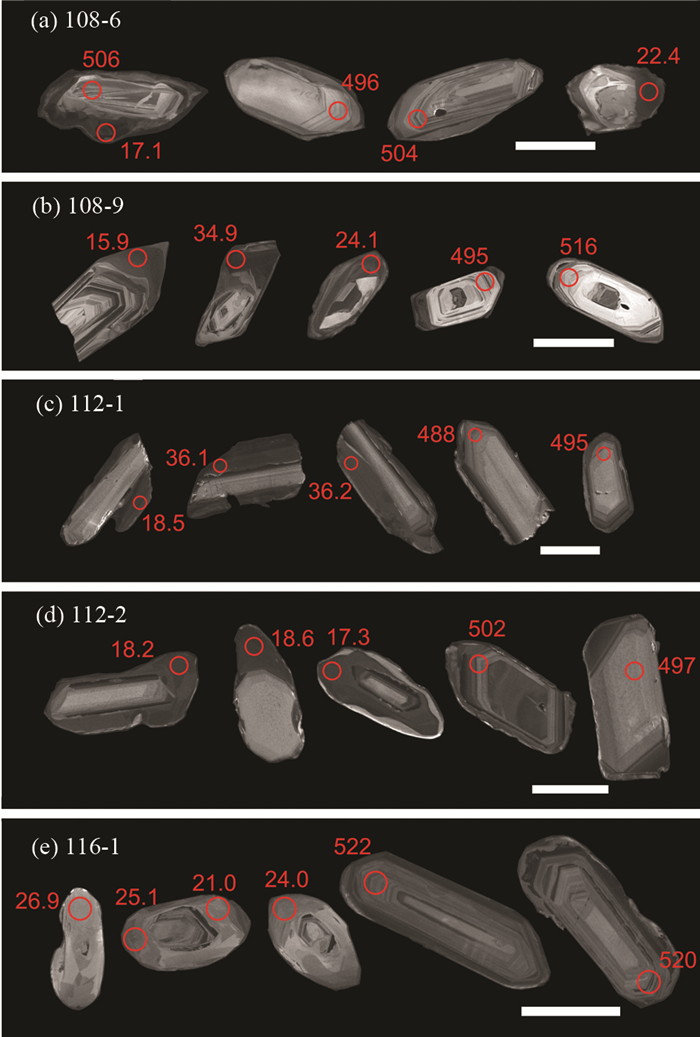
|
图 8 错那地区正片麻岩代表性锆石阴极发光图像 圆圈为U-Pb定年位置;数字为年龄(Ma);图中比例尺为100μm Fig. 8 Cathodoluminescence (CL) images of the representing zircon grains from the Cona orthogneisses, showing the locations of analyzed spots and relevant ages (Ma) |

|
图 9 错那地区正片麻岩中锆石的U-Pb年龄谐和图(a-e)和锆石稀土元素配分模式图(f-j, 标准化值据Sun and McDonough, 1989) Fig. 9 Zircon U-Pb concordia diagrams (a-e) and chondrite-normalized REE patterns (f-j, normalization values after Sun and McDonough, 1989) of the Cona orthogneiss |
锆石U-Pb定年结果表明5个样品锆石核部具有可变的206Pb/238U年龄,为56~525Ma,但大部分分析点年龄在470~525Ma之间(图 9a-e、附表 1),其加权平均年龄在491Ma至513Ma之间(图 9a-e)。5个样品锆石边部分析点给出的206Pb/238U年龄分别为17.1~22.4Ma、15.1~23.2Ma、18.5~19.8Ma、16.3~18.6Ma和17.6~26.9Ma。此外,值得注意的是,样品112-2的锆石边部重稀土含量随年龄变小具有升高的趋势(图 9i)。
5个样品中的独居石多为浅黄色、半自形或他形粒状,颗粒大小约80~100μm。这些独居石具有不同的环带和微量元素特征(图 10、图 11、附表 2)。样品108-6中的独居石包括两个发光不同的域(图 10a)。但分析结果表明,两个不同的域在年龄及微量元素(重稀土和Y)成分上没有系统差别。分析点具有可变的重稀土(HREE=162×10-6~2006×10-6)和Y(4441×10-6~21386×10-6)含量,206Pb/238U年龄范围为16.5~20.7Ma(图 11a, b、附表 2)。样品108-9中的独居石具有弱的震荡环带(图 10b),和相对高的重稀土含量(HREE=1362×10-6~6247×10-6),其206Pb/238U年龄范围为12.6~16.4Ma(图 11c, d、附表 2)。样品112-1中的独居石具有弱环带或无环带结构(图 10c),具有可变的重稀土(HREE)和Y含量,分别为217×10-6~2113×10-6和3671×10-6~22358×10-6,206Pb/238U年龄范围为14.8~18.1Ma(图 11e, f、附表 2)。样品112-2中的独居石具有不规则的浅色核部和较暗的边部域(图 10d)。核部分析点具有相对低的重稀土含量(HREE=234×10-6~1910×10-6)和较老的206Pb/238U年龄(16.4~17.6Ma),而边部分析点具有相对高的重稀土含量(HREE=331×10-6~3012×10-6)和较年轻的206Pb/238U年龄(11.2~16.0Ma;图 11g, h、附表 2)。样品116-1中的独居石具有以核部呈白色或浅色为特征的同心环带状核~边结构(图 10e)。核部分析点具有相对低的重稀土含量(HREE=367×10-6~2273×10-6)和较老的206Pb/238U年龄(18.4~25.6Ma),而边部分析点则具有较高的重稀土含量(HREE=724×10-6~3530×10-6)和较年轻的206Pb/238U年龄(13.0~18.3Ma)(图 11i, j、附表 2)。此外,5个样品的独居石年龄与重稀土含量呈负相关关系(图 12)。
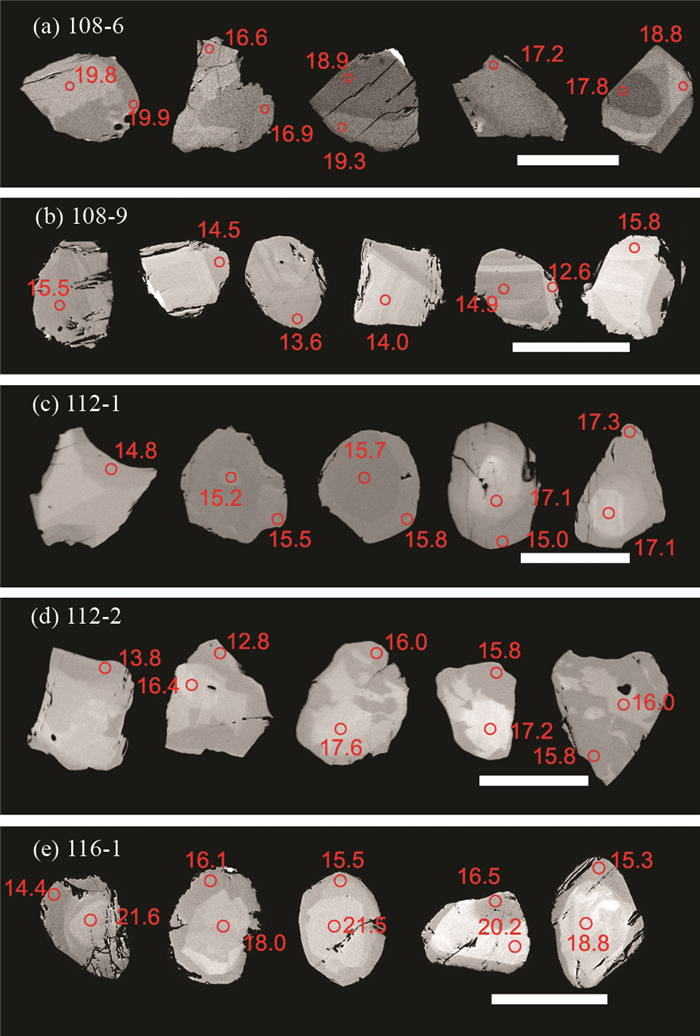
|
图 10 错那地区正片麻岩代表性独居石背散射图像 圆圈为U-Pb定年位置,数字为年龄(Ma);图中比例尺为100μm Fig. 10 BSE images of the representing monazite grains from the Cona orthogneiss, showing the locations of analyzed spots and relevant ages (Ma) |

|
图 11 错那地区正片麻岩中独居石的U-Pb年龄谐和图(a、c、e、g、i)和稀土元素配分模式(b、d、f、h、j, 标准化值据Sun and McDonough, 1989) Fig. 11 Monazite U-Pb concordia diagrams (a, c, e, g, i) and chondrite-normalized REE patterns (b, d, f, h, j, normalization values after Sun and McDonough, 1989) of the Cona orthogneiss |

|
图 12 错那地区正片麻岩中独居石U-Pb年龄与重稀土元素含量关系图 Fig. 12 Plot of U-Pb age versus ΣHREE contents of the Cona orthogneiss |
先前的大多数研究认为,高喜马拉雅结晶岩系经历了巴罗型中压变质作用(Pêcher, 1989; Guillot, 1999; Hodges, 2000)。而且,在高喜马拉雅结晶岩系下部发育有倒转变质带。以前的研究也表明,高喜马拉雅结晶岩系上部构造层位经历了中-低压、高温变质作用,相当夕线石-钾长石或堇青石带(Harrison et al., 1997; Fraser et al., 2000; Hodges, 2000; Stephenson et al., 2000; Dasgupta et al., 2004; Caddick et al., 2007; Jessup et al., 2008; Searle et al., 2011; Yakymchuk and Godin, 2012; Mottram et al., 2014)。但最近的研究表明,在造山带中东段,高喜马拉雅岩系的上部构造层位经历了中-高压、高温变质作用,如,定结地区的片麻岩和变基性岩经历了高压麻粒岩相-榴辉岩相变质作用(14kbar和875℃, Kali et al., 2010; 20~21kbar和720~760℃, Wang et al., 2016)。在锡金-亚东和东构造结,高喜马拉雅结晶岩系上部构造层位岩石经历了麻粒岩相(8~10kbar和~850℃, Groppo et al., 2012)或高压麻粒岩相变质作用(9~12kbar和~800℃, Faak et al., 2012; 9~12kbar和750~800℃, Sorcar et al., 2014; 12.8~14kbar和800~835℃, 李旺超等, 2015; 13~16kbar和840~880℃, Zhang et al., 2015; 12kbar和825~845℃, Zhang et al., 2017)(图 1、图 7)。本研究的5个样品来自高喜马拉雅结晶岩系上部构造层位,其中两个样品明显是来自最上部构造层位,所记录的高角闪岩相变条件(9.5~10.5kbar和710~730℃)进一步证明造山带东段的高喜马拉雅结晶岩系上部构造层位经历了中高压、高温变质作用和部分熔融。
如前所述,所研究的岩石经历了以早期升温、升压进变质作用过程和晚期降温、降压退变质作用过程为特征的顺时针P-T轨迹。这种顺时针型的P-T轨迹广泛被高喜马拉雅结晶岩系变质岩记录(图 7),为碰撞造山带变质作用的典型特征,指示高喜马拉雅结晶岩系的变质作用发生在印度大陆俯冲所导致的地壳加厚过程中,并经历了后期显著降压折返过程。
7.2 变质作用时间如上文所述,所研究的5个片麻岩样品中的锆石具有核-边结构,核部具有明显震荡环带(图 8),较高的Th/U比值(附表 1)以及明显分馏的轻、重稀土模式和负Eu异常(图 9f-j)。这表明锆石核部是岩浆结晶成因(Hoskin and Schaltegger, 2003),所获得的491Ma至513Ma加权平均年龄代表片麻岩的原岩年龄。以前的研究已经表明,高喜马拉雅结晶岩系中普遍存在早古生代的花岗岩,其形成在环冈瓦纳超大陆北缘的安底斯型造山过程中(Cawood et al., 2007; 张泽明等, 2008; 王晓先等, 2011; Wang et al., 2012)。
所研究片麻岩中的锆石边部具有弱发光的补丁状环带(图 8)、低的Th/U比值(附表 1),与其岩浆核相比,具有较低的HREE含量和相对弱的轻、重稀土分馏模式(图 9f-j)。这些都表明锆石边部是变质成因(Rubatto, 2002; Corfu et al., 2003)。因此,锆石边部所获得的27~15Ma年龄代表岩石的变质作用年龄。所研究的5个片麻岩中的独居石获得了26~11Ma年龄,与其变质锆石年龄类似,也应代表岩石的变质年龄。
如前所述,样品112-2中锆石边部,以及样品112-2和116-1中独居石的重稀土含量具有随年龄变小而明显增加的趋势(图 9i、图 11h, j),而且5个样品的独居石年龄与重稀土含量呈负相关关系(图 12)。这些特征说明锆石的变质边和独居石形成在石榴石体积减少的退变质作用过程中(图 6b, d, f)。因此,变质锆石和独居石所获得的27~11Ma年龄很可能代表片麻岩从峰期到退变质期的时间(图 7)。这一年龄范围与造山带中-东段高喜马拉雅结晶岩系的退变质年龄25~7Ma(Zhang et al., 2015)及28~18Ma(Iaccarino et al., 2015)相一致(图 7)。
7.3 部分熔融机制大量研究表明,高喜马拉雅结晶岩系经历了不同程度的部分熔融和相关的岩浆作用。先前的研究多认为部分熔融发生在近等温、降压折返过程中(Patiño Douce and Harris, 1998; Harris et al., 2004; Zhang et al., 2004a, b)。而本文的相平衡模拟表明,所研究的片麻岩在进变质晚期至峰期阶段发生了白云母脱水熔融(图 6a, c, e)。而在退变质过程中,由于岩石退变质P-T轨迹具降温、降压特征,其与熔体含量等值线斜交,熔体的含量将逐渐减少(图 6a, c, e)。这表明岩石的部分熔融并不是发生在降压过程中。最近的相平衡模拟均表明,高喜马拉雅结晶岩系的部分熔融主要发生在进变质至峰期变质作用过程中(Guilmette et al., 2011; Groppo et al., 2012; Iaccarino et al., 2015; 李旺超等, 2015; Zhang et al., 2015, 2017)。
最近的研究表明,特提斯喜马拉雅淡色花岗岩带中发育有许多始新世(约44~35Ma)淡色花岗岩,被认为是造山带地壳加厚部分熔融的产物,即形成在高喜马拉雅结晶岩系的进变质过程中(Aikman et al., 2008; Zeng et al., 2011; Hou et al., 2012; Liu et al., 2016)。另外,也有研究表明淡色花岗岩的锆石结晶年龄可能明显晚于其源区的部分熔融年龄,二者可能有约20Ma的时间间隔(Gou et al., 2016)。区域上广泛分布的中新世淡色花岗岩很可能形成在高喜马拉雅结晶岩系进变质-峰期变质作用过程中,只是在中新世时期侵位和结晶。当然,我们也不能排除高喜马拉雅结晶岩系折返过程中的部分熔融形成了某些中新世的淡色花岗岩(张泽明等, 2017)。
7.4 高喜马拉雅结晶岩系内部的构造变质不连续性以前的研究认为,作为造山带变质核的GHS尽管经历了复杂的变形历史,但它是一个相对均匀和连续的岩石构造单元(Le Fort, 1975; Searle and Godin, 2003; Yin and Harrison, 2000; Yin, 2006)。但是,越来越多的研究表明,GHS内部是不均匀的,存在明显的剪切带或构造变质不连续,即高喜马拉雅结晶岩系是由两个或多个不同变质条件和(或)不同变质时间的构造岩片组成的(Larson et al., 2013, 2015; Larson and Cottle, 2014; Montomoli et al., 2013, 2015; Ambrose et al., 2015; Wang et al., 2015a, 2016; Ding et al., 2016b; Rapa et al., 2016)。本文进行相平衡模拟的片麻岩采自高喜马拉雅结晶岩系上部构造层位,相距约10km(图 1、图 2)。这些片麻岩的峰期变质条件和退变质年龄没有明显差异。这表明研究区高喜马拉雅结晶岩系上部构造层位是相对均匀和连续的,并不存在构造变质不连续。在造山带中段所揭示出的构造不连续很可能存在于研究区的更南部,如在GHS中部构造层位发育的Zimithang断裂(Yin et al., 2006, 2010; Warren et al., 2014)。
8 结论喜马拉雅造山带东段错那地区发育有原岩为早古生代(510~490Ma)的正片麻岩。这些岩石经历了高角闪岩相变质作用和部分熔融,其峰期矿物组合为石榴石+斜长石+钾长石+黑云母+白云母+石英+钛铁矿。相平衡模拟显示,片麻岩的峰期变质条件为710~750℃和9.0~10.5kbar,记录了一个顺时针P-T轨迹,其进变质过程以升温、升压与部分熔融为特征,退变质作用为降温、降压过程。锆石和独居石U-Pb定年结果表明,片麻岩的退变质作用发生在渐新世-中新世(约27~11Ma)。本研究不仅表明高喜马拉雅结晶岩系上部构造层位的部分熔融发生在印度大陆俯冲地壳加厚过程中,而且揭示出高喜马拉雅结晶岩系最上部构造层位不存在构造变质不连续现象。
致谢 中国地质大学(北京)赵志丹教授、中国地质大学(武汉)郭亮副教授和中国科学院地质与地球物理研究所王佳敏博士审阅全文并提出了宝贵意见。李旺超和毛玲娟参与了野外工作。在此一并表示感谢!| [] | Aikman AB, Harrison TM, Lin D. 2008. Evidence for early ( > 44Ma) Himalayan crustal thickening, Tethyan Himalaya, Southeastern Tibet. Earth and Planetary Science Letters, 274(1-2): 14–23. DOI:10.1016/j.epsl.2008.06.038 |
| [] | Ambrose TK, Larson KP, Guilmette C, Cottle JM, Buckingham H, Rai S. 2015. Lateral extrusion, underplating, and out-of-sequence thrusting within the Himalayan metamorphic core, Kanchenjunga, Nepal. Lithosphere, 7(4): 441–464. DOI:10.1130/L437.1 |
| [] | Caddick MJ, Bickle MJ, Harris NBW, Holland TJB, Horstwood MSA, Parrish RR, Ahmad T. 2007. Burial and exhumation history of a Lesser Himalayan schist:Recording the formation of an inverted metamorphic sequence in NW India. Earth and Planetary Science Letters, 264(3-4): 375–390. DOI:10.1016/j.epsl.2007.09.011 |
| [] | Cawood PA, Johnson MRW, Nemchin AA. 2007. Early Palaeozoic orogenesis along the IndianMargin of Gondwana:Tectonic response to Gondwana assembly. Earth and Planetary Science Letters, 255(1-2): 70–84. DOI:10.1016/j.epsl.2006.12.006 |
| [] | Corfu F, Hanchar JM, Hoskin PWO, Kinny P. 2003. Atlas of zircon textures. Reviews in Mineralogy and Geochemistry, 53(1): 469–500. DOI:10.2113/0530469 |
| [] | Corrie SL, Kohn MJ and Vervoort JD. 2010. Young eclogite from the Greater Himalayan Sequence, Arun Valley, eastern Nepal:P-T-t path and tectonic implications. Earth and Planetary Science Letters, 289(3-4): 406–416. DOI:10.1016/j.epsl.2009.11.029 |
| [] | Cottle JM, Searle MP, Horstwood MSA, Waters DJ. 2009. Timing of midcrustal metamorphism, melting, and deformation in the Mount Everest region of Southern Tibet revealed by U(-Th)-Pb geochronology. The Journal of Geology, 117(6): 643–664. DOI:10.1086/605994 |
| [] | Dasgupta S, Ganguly J, Neogi S. 2004. Inverted metamorphic sequence in the Sikkim Himalayas:Crystallization history, P-T gradient and implications. Journal of Metamorphic Geology, 22(5): 395–412. DOI:10.1111/jmg.2004.22.issue-5 |
| [] | Ding HX, Zhang ZM. 2016. Neoproterozoic granitoids in the eastern Himalayan orogen and their tectonic implications. Precambrian Research, 285: 1–9. DOI:10.1016/j.precamres.2016.09.005 |
| [] | Ding HX, Zhang ZM, Dong X, Tian ZL, Xiang H, Mu HC, Gou ZB, Shui XF, Li WC, Mao LJ. 2016a. Early Eocene (ca.50Ma) collision of the Indian and Asian continents:Constraints from the North Himalayan metamorphic rocks, southeastern Tibet. Earth and Planetary Science Letters, 435: 64–73. DOI:10.1016/j.epsl.2015.12.006 |
| [] | Ding HX, Zhang ZM, Hu KM, Dong X, Xiang H, Mu HC. 2016b. P-T-t-D paths of the North Himalayan metamorphic rocks:Implications for the Himalayan orogeny. Tectonophysics, 683: 393–404. DOI:10.1016/j.tecto.2016.06.035 |
| [] | Ding L, Zhong DL. 1999. Metamorphic characteristics and geotectonic implications of the high-pressure granulites from Namjagbarwa, eastern Tibet. Science in China (Series D), 42(5): 491–505. DOI:10.1007/BF02875243 |
| [] | Ding L, Zhong DL, Yin A, Kapp P, Harrison TM. 2001. Cenozoic structural and metamorphic evolution of the eastern Himalayan syntaxis (Namche Barwa). Earth and Planetary Science Letters, 192(3): 423–438. DOI:10.1016/S0012-821X(01)00463-0 |
| [] | Faak K, Chakraborty S, Dasgupta S. 2012. Petrology and tectonic significance of metabasite slivers in the Lesser and Higher Himalayan domains of Sikkim, India. Journal of Metamorphic Geology, 30(6): 599–622. DOI:10.1111/jmg.2012.30.issue-6 |
| [] | Fraser G, Worley B, Sandiford M. 2000. High-precision geothermobarometry across the High Himalayan metamorphic sequence, Langtang valley, Nepal. Journal of Metamorphic Geology, 18(6): 665–681. DOI:10.1046/j.1525-1314.2000.00283.x |
| [] | Gao LE. 2010. Metamorphic and anatetic events in the Yardoi gneiss dome, Southern Tibet. Master Degree Thesis. Beijing:Chinese Academy of Geological Sciences: 1–147. |
| [] | Godin L, Parrish RR, Brown RL, Hodges KV. 2001. Crustal thickening leading to exhumation of the Himalayan metamorphic core of central Nepal:Insight from U-Pb geochronology and 40Ar/39Ar thermochronology. Tectonics, 20(5): 729–747. DOI:10.1029/2000TC001204 |
| [] | Goscombe B, Hand M. 2000. Contrasting P-T paths in the Eastern Himalaya, Nepal:Inverted isograds in a paired metamorphic mountain belt. Journal of Petrology, 41(12): 1673–1719. DOI:10.1093/petrology/41.12.1673 |
| [] | Gou ZB, Zhang ZM, Dong X, Xiang H, Ding HX, Tian ZL, Lei HC. 2016. Petrogenesis and tectonic implications of the Yadong leucogranites, southern Himalaya. Lithos, 256-257: 300–310. DOI:10.1016/j.lithos.2016.04.009 |
| [] | Groppo C, Lombardo B, Rolfo F, Pertusati P. 2007. Clockwise exhumation path of granulitized eclogites from the Ama Drime range (Eastern Himalayas). Journal of Metamorphic Geology, 25(1): 51–75. DOI:10.1111/jmg.2007.25.issue-1 |
| [] | Groppo C, Rolfo F, Lombardo B. 2009. P-T evolution across the Main Central Thrust Zone (Eastern Nepal):Hidden discontinuities revealed by petrology. Journal of Petrology, 50(6): 1149–1180. DOI:10.1093/petrology/egp036 |
| [] | Groppo C, Rolfo F, Indares A. 2012. Partial melting in the Higher Himalayan crystallines of Eastern Nepal:The effect of decompression and implications for the 'channel flow' model. Journal of Petrology, 53(5): 1057–1088. DOI:10.1093/petrology/egs009 |
| [] | Guillot S. 1999. An overview of the metamorphic evolution in Central Nepal. Journal of Asian Earth Sciences, 17(5-6): 713–725. DOI:10.1016/S1367-9120(99)00045-0 |
| [] | Guilmette C, Indares A, Hébert R. 2011. High-pressure anatectic paragneisses from the Namche Barwa, Eastern Himalayan Syntaxis:Textural evidence for partial melting, phase equilibria modeling and tectonic implications. Lithos, 124(1-2): 66–81. DOI:10.1016/j.lithos.2010.09.003 |
| [] | Guo ZF, Wilson M. 2012. The Himalayan leucogranites:Constraints on the nature of their crustal source region and geodynamic setting. Gondwana Research, 22(2): 360–376. DOI:10.1016/j.gr.2011.07.027 |
| [] | Harris N, Massey J. 1994. Decompression and anatexis of Himalayan metapelites. Tectonics, 13(6): 1537–1546. DOI:10.1029/94TC01611 |
| [] | Harris NBW, Caddick M, Kosler J, Goswami S, Vance D, Tindle AG. 2004. The pressure-temperature-time path of migmatites from the Sikkim Himalaya. Journal of Metamorphic Geology, 22(3): 249–264. DOI:10.1111/jmg.2004.22.issue-3 |
| [] | Harrison TM, Ryerson FJ, Le Fort P, Yin A, Lovera OM, Catlos EJ. 1997. A Late Miocene-Pliocene origin for the Central Himalayan inverted metamorphism. Earth and Planetary Science Letters, 146(1-2): E1–E7. DOI:10.1016/S0012-821X(96)00215-4 |
| [] | Hodges KV. 2000. Tectonics of the Himalaya and southern Tibet from two perspectives. GSA Bulletin, 112(3): 324–350. DOI:10.1130/0016-7606(2000)112<324:TOTHAS>2.0.CO;2 |
| [] | Hodges KV, Le Fort P, Pêcher A. 1988. Possible thermal buffering by crustal anatexis in collisional orogens:Thermobarometric evidence from the Nepalese Himalaya. Geology, 16(8): 707–710. DOI:10.1130/0091-7613(1988)016<0707:PTBBCA>2.3.CO;2 |
| [] | Holland TJ, Powell R. 1998. An internally consistent thermodynamic data set for phases of petrological interest. Journal of Metamorphic Geology, 16(3): 309–343. |
| [] | Hoskin PWO, Schaltegger U. 2003. The composition of zircon and igneous and metamorphic petrogenesis. Reviews in Mineralogy and Geochemistry, 53(1): 27–62. DOI:10.2113/0530027 |
| [] | Hou ZQ, Zheng YC, Zeng LS, Gao LE, Huang KX, Li W, Li QY, Fu Q, Liang W, Sun QZ. 2012. Eocene-Oligocene granitoids in Southern Tibet:Constraints on crustal anatexis and tectonic evolution of the Himalayan orogen. Earth and Planetary Science Letters, 349-350: 38–52. DOI:10.1016/j.epsl.2012.06.030 |
| [] | Iaccarino S, Montomoli C, Carosi R, Massonne HJ, Langone A, Visonà D. 2015. Pressure-temperature-time-deformation path of kyanite-bearing migmatitic paragneiss in the Kali Gandaki valley (Central Nepal):Investigation of Late Eocene-Early Oligocene melting processes. Lithos, 231: 103–121. DOI:10.1016/j.lithos.2015.06.005 |
| [] | Jackson SE, Pearson NJ, Griffin WL, Belousova EA. 2004. The application of laser ablation-inductively coupled plasma-mass spectrometry to in situ U-Pb zircon geochronology. Chemical Geology, 211(1-2): 47–69. DOI:10.1016/j.chemgeo.2004.06.017 |
| [] | Jessup MJ, Cottle JM, Searle MP, Law RD, Newell DL, Tracy RJ, Waters DJ. 2008. P-T-t-D paths of Everest Series schist, Nepal. Journal of Metamorphic Geology, 26(7): 717–739. DOI:10.1111/jmg.2008.26.issue-7 |
| [] | Kali E, Leloup PH, Arnaud N, Mahéo G, Liu DY, Boutonnet E, Van der Woerd J, Liu XH, Liu-Zeng J, Li HB. 2010. Exhumation history of the deepest central Himalayan rocks, Ama Drime range:Key pressure-temperature-deformation-time constraints on orogenic models. Tectonics, 29(2): TC2014. |
| [] | King J, Harris N, Argles T, Parrish R, Zhang HF. 2011. Contribution of crustal anatexis to the tectonic evolution of Indian crust beneath southern Tibet. GSA Bulletin, 123(1-2): 218–239. DOI:10.1130/B30085.1 |
| [] | Kohn MJ. 2008. P-T-t data from central Nepal support critical taper and repudiate large-scale channel flow of the Greater Himalayan Sequence. GSA Bulletin, 120(3-4): 259–273. DOI:10.1130/B26252.1 |
| [] | Kohn MJ. 2014. Himalayan metamorphism and its tectonic implications. Annual Review of Earth and Planetary Sciences, 42(1): 381–419. DOI:10.1146/annurev-earth-060313-055005 |
| [] | Larson KP, Gervais F, Kellett DA. 2013. A P-T-t-D discontinuity in east-central Nepal:Implications for the evolution of the Himalayan mid-crust. Lithos, 179: 275–292. DOI:10.1016/j.lithos.2013.08.012 |
| [] | Larson KP, Cottle JM. 2014. Mid-crustal discontinuities and the assembly of the Himalayan midcrust. Tectonics, 33(5): 718–740. DOI:10.1002/2013TC003452 |
| [] | Larson KP, Ambrose TK, Webb AAG, Cottle JM, Shrestha S. 2015. Reconciling Himalayan midcrustal discontinuities:The Main Central Thrust System. Earth and Planetary Science Letters, 429: 139–146. DOI:10.1016/j.epsl.2015.07.070 |
| [] | Le Fort P. 1975. Himalayas:The collided range. Present knowledge of the continental arc. American Journal of Science, 275A: 1–44. |
| [] | Lee J, Hacker B, Wang Y. 2004. Evolution of North Himalayan gneiss domes:Structural and metamorphic studies in Mabja Dome, southern Tibet. Journal of Structural Geology, 26(12): 2297–2316. DOI:10.1016/j.jsg.2004.02.013 |
| [] | Lee J, Whitehouse MJ. 2007. Onset of mid-crustal extensional flow in southern Tibet:Evidence from U/Pb zircon ages. Geology, 35(1): 45–48. DOI:10.1130/G22842A.1 |
| [] | Li WC, Zhang ZM, Xiang H, Gou ZB, Ding HX. 2015. Metamorphism and anatexis of the Himalayan orogen:Petrology and geochronology of HP pelitic granulites from the Yadong area, Southern Tibet. Acta Petrologica Sinica, 31(5): 1219–1234. |
| [] | Liu Y, Zhong D. 1997. Petrology of high-pressure granulites from the eastern Himalayan syntaxis. Journal of Metamorphic Geology, 15(4): 451–466. DOI:10.1111/j.1525-1314.1997.00033.x |
| [] | Liu YS, Gao S, Hu ZC, Gao CG, Zong KQ, Wang DB. 2010a. Continental and oceanic crust recycling-induced melt-peridotite interactions in Pb dating, Hf isotopes and trace elements in zircons fromMantle xenoliths. Journal of Petrology, 51(1-2): 537–571. DOI:10.1093/petrology/egp082 |
| [] | Liu YS, Hu ZC, Zong KQ, Gao CG, Gao S, Xu J, Chen HH. 2010b. Reappraisement and refinement of zircon U-Pb isotope and trace element analyses by LA-ICP-MS. Chinese Science Bulletin, 55(5): 1535–1546. |
| [] | Liu ZC, Wu FY, Ding L, Liu XC, Wang JG, Ji WQ. 2016. Highly fractionated Late Eocene (~35Ma) leucogranite in the Xiaru Dome, Tethyan Himalaya, South Tibet. Lithos, 240-243: 337–354. DOI:10.1016/j.lithos.2015.11.026 |
| [] | Ludwig KR. 2003. Isoplot/Ex Version 3.00:A Geochronological Toolkit for Microsoft Excel. Special Publication, No.4. Berkeley:Berkeley Geochronology Center, 1-73 |
| [] | Martin AJ, Gehrels GE, DeCelles PG. 2007. The tectonic significance of (U, Th)/Pb ages of monazite inclusions in garnet from the Himalaya of central Nepal. Chemical Geology, 244(1-2): 1–24. DOI:10.1016/j.chemgeo.2007.05.003 |
| [] | Montomoli C, Iaccarino S, Carosi R, Langone A, Visonà D. 2013. Tectonometamorphic discontinuities within the Greater Himalayan Sequence in Western Nepal (Central Himalaya):Insights on the exhumation of crystalline rocks. Tectonophysics, 608: 1349–1370. DOI:10.1016/j.tecto.2013.06.006 |
| [] | Montomoli C, Carosi R and Iaccarino S. 2015. Tectonometamorphic discontinuities in the Greater Himalayan Sequence:A local or a regional feature? In:Mukherjee S, Carosi R, van der Beek PA, Mukherjee BK and Robinson DM (eds.). Tectonics of the Himalaya. Geological Society, London, Special Publications, 412(1):25-41 |
| [] | Mottram CM, Warren CJ, Regis D, Roberts NMW, Harris NBW, Argles TW, Parrish RR. 2014. Developing an inverted Barrovian sequence; insights from monazite petrochronology. Earth and Planetary Science Letters, 403: 418–431. DOI:10.1016/j.epsl.2014.07.006 |
| [] | Patiño Douce AE, Harris N. 1998. Experimental constraints on Himalayan anatexis. Journal of Petrology, 39(4): 689–710. DOI:10.1093/petroj/39.4.689 |
| [] | Pêcher A. 1989. The metamorphism in the central Himalaya. Journal of Metamorphic Geology, 7(1): 31–41. DOI:10.1111/jmg.1989.7.issue-1 |
| [] | Pognante U and Benna P. 1993. Metamorphic zonation, migmatization and leucogranites along the Everest transect of Eastern Nepal and Tibet:Record of an exhumation history. In:Treloar PJ and Searle MP (eds.). Himalayan Tectonics. Geological Society, London, Special Publications, 74(1):323-340 |
| [] | Rapa G, Groppo C, Mosca P, Rolfo F. 2016. Petrological constraints on the tectonic setting of the Kathmandu Nappe in the Langtang-Gosainkund-Helambu regions, Central Nepal Himalaya. Journal of Metamorphic Geology, 34(9): 999–1023. DOI:10.1111/jmg.2016.34.issue-9 |
| [] | Rubatto D. 2002. Zircon trace element geochemistry:Partitioning with garnet and the link between U-Pb ages and metamorphism. Chemical Geology, 184(1-2): 123–138. DOI:10.1016/S0009-2541(01)00355-2 |
| [] | Rubatto D, Chakraborty S, Dasgupta S. 2013. Timescales of crustal melting in the Higher Himalayan Crystallines (Sikkim, Eastern Himalaya) inferred from trace element-constrained monazite and zircon chronology. Contributions to Mineralogy and Petrology, 165(2): 349–372. DOI:10.1007/s00410-012-0812-y |
| [] | Searle MP, Godin L. 2003. The South Tibetan Detachment and the Manaslu Leucogranite:A structural reinterpretation and restoration of the Annapurna-Manaslu Himalaya, Nepal. The Journal of Geology, 111(5): 505–523. DOI:10.1086/376763 |
| [] | Searle MP, Simpson RL, Law RD, Parrish RR, Waters DJ. 2003. The structural geometry, metamorphic and Magmatic evolution of the Everest Massif, High Himalaya of Nepal-South Tibet. Journal of the Geological Society, 160(3): 345–366. DOI:10.1144/0016-764902-126 |
| [] | Searle MP, Law RD and Jessup M. 2006. Crustal structure, restoration and evolution of the Greater Himalaya in Nepal-South Tibet:Implications for channel flow and ductile extrusion of the middle crust. In:Law RD, Searle MP and Godin L (eds.). Channel Flow, Ductile Extrusion and Exhumation in Continental Collision Zones. Geological Society, London, Special Publications, 268(1):355-378 |
| [] | Searle MP, Elliott JR, Phillips RJ, Chung SL. 2011. Crustal-lithospheric structure and continental extrusion of Tibet. Journal of the Geological Society, 168(3): 633–672. DOI:10.1144/0016-76492010-139 |
| [] | Simpson RL, Parrish RR, Searle MP, Waters DJ. 2000. Two episodes of monazite crystallization during metamorphism and crustal melting in the Everest region of the Nepalese Himalaya. Geology, 28(5): 403–406. DOI:10.1130/0091-7613(2000)28<403:TEOMCD>2.0.CO;2 |
| [] | Sorcar N, Hoppe U, Dasgupta S, Chakraborty S. 2014. High-temperature cooling histories of migmatites from the High Himalayan Crystallines in Sikkim, India:Rapid cooling unrelated to exhumation?. Contributions to Mineralogy and Petrology, 167(2): 957. DOI:10.1007/s00410-013-0957-3 |
| [] | Spear FS, Kohn MJ, Florence FP, Menard T. 1990. A model for garnet and plagioclase growth in pelitic schists:Implications for thermobarometry and P-T path determinations. Journal of Metamorphic Geology, 8(6): 683–696. DOI:10.1111/jmg.1990.8.issue-6 |
| [] | Stearns M, Hacker BR, Ratschbacher L, Lee J, Cottle JM, Kylander-Clark A. 2013. Synchronous Oligocene-Miocene metamorphism of the Pamir and the North Himalaya driven by plate-scale dynamics. Geology, 41(10): 1071–1074. DOI:10.1130/G34451.1 |
| [] | Stephenson BJ, Waters DJ, Searle MP. 2000. Inverted metamorphism and the Main Central Thrust:Field relations and thermobarometric constraints from the Kishtwar Window, NW Indian Himalaya. Journal of Metamorphic Geology, 18(5): 571–590. DOI:10.1046/j.1525-1314.2000.00277.x |
| [] | Streule MJ, Searle MP, Waters DJ, Horstwood MSA. 2010. Metamorphism, melting, and channel flow in the Greater Himalayan Sequence and Makalu leucogranite:Constraints from thermobarometry, metamorphic modeling, and U-Pb geochronology. Tectonics, 29(5): TC5011. |
| [] | Sun SS and McDonough WF. 1989. Chemical and isotopic systematics of oceanic basalts:Implications for Mantle composition and processes. In:Saunders AD and Norry MJ (eds.). Magmatism in the Ocean Basins. Geological Society, London, Special Publications, 42(1):313-345 |
| [] | Vannay JC, Hodges KV. 1996. Tectonometamorphic evolution of the Himalayan metamorphic core between the Annapurna and Dhaulagiri, central Nepal. Journal of Metamorphic Geology, 14(5): 635–656. |
| [] | Vernon RH, Clarke GL. 2008. Principles of Metamorphic Petrology. Cambridge, UK: Cambridge University Press. |
| [] | Visonà D, Carosi R, Montomoli C, Tiepolo M, Peruzzo L. 2012. Miocene andalusite leucogranite in central-east Himalaya (Everest-Masang Kang area):Low-pressure melting during heating. Lithos, 144-145: 194–208. DOI:10.1016/j.lithos.2012.04.012 |
| [] | Wang JM, Zhang JJ, Wang XX. 2013. Structural kinematics, metamorphic P-T profiles and zircon geochronology across the Greater Himalayan Crystalline Complex in south-central Tibet:Implication for a revised channel flow. Journal of Metamorphic Geology, 31(6): 607–628. DOI:10.1111/jmg.2013.31.issue-6 |
| [] | Wang JM, Rubatto D, Zhang JJ. 2015a. Timing of partial melting and cooling across the Greater Himalayan crystalline complex (Nyalam, Central Himalaya):In-sequence thrusting and its implications. Journal of Petrology, 56(9): 1677–1702. DOI:10.1093/petrology/egv050 |
| [] | Wang JM, Zhang JJ, Wei CJ, Rai S, Wang M, Qian JH. 2015b. Characterising the metamorphic discontinuity across the Main Central Thrust Zone of eastern-central Nepal. Journal of Asian Earth Sciences, 101: 83–100. DOI:10.1016/j.jseaes.2015.01.027 |
| [] | Wang JM, Zhang JJ, Liu K, Zhang B, Wang XX, Rai S, Scheltens M. 2016. Spatial and temporal evolution of tectonometamorphic discontinuities in the central Himalaya:Constraints from P-T paths and geochronology. Tectonophysics, 679: 41–60. DOI:10.1016/j.tecto.2016.04.035 |
| [] | Wang XX, Zhang JJ, Yang XY, Zhang B. 2011. Zircon SHRIMP U-Pb ages, Hf isotopic features and their geological significance of the Greater Himalayan Crystalline Complex augen gneiss in Gyirong Area, South Tibet. Earth Science Frontiers, 18(2): 127–139. |
| [] | Wang XX, Zhang JJ, Santosh M, Liu J, Yan SY, Guo L. 2012. Andean-type orogeny in the Himalayas of South Tibet:Implications for Early Paleozoic tectonics along the Indian Margin of Gondwana. Lithos, 154: 248–262. DOI:10.1016/j.lithos.2012.07.011 |
| [] | Wang YH, Zhang LF, Zhang JJ, Wei CJ. 2017a. The youngest eclogite in central Himalaya:P-T path, U-Pb zircon age and its tectonic implication. Gondwana Research, 41: 188–206. DOI:10.1016/j.gr.2015.10.013 |
| [] | Wang YH, Zeng LS, Gao LE, Guo CL, Hou KJ, Zhang LF, Wang W, Sun HY. 2017b. Neoproterozoic magmatism in eastern Himalayan terrane. Science Bulletin, 62(6): 415–424. DOI:10.1016/j.scib.2017.02.003 |
| [] | Warren CJ, Singh AK, Roberts NMW, Regis D, Halton AM, Singh RB. 2014. Timing and conditions of peak metamorphism and cooling across the Zimithang Thrust, Arunachal Pradesh, India. Lithos, 200-201: 94–110. DOI:10.1016/j.lithos.2014.04.005 |
| [] | Wu CM, Chen HX. 2015. Revised Ti-in-biotite geothermometer for ilmenite-or rutile-bearing crustal metapelites. Science Bulletin, 60(1): 116–121. DOI:10.1007/s11434-014-0674-y |
| [] | Yakymchuk C, Godin L. 2012. Coupled role of deformation and metamorphism in the construction of inverted metamorphic sequences:An example from far-northwest Nepal. Journal of Metamorphic Geology, 30(5): 513–535. DOI:10.1111/jmg.2012.30.issue-5 |
| [] | Yin A, Harrison TM. 2000. Geologic evolution of the Himalayan-Tibetan orogen. Annual Review of Earth and Planetary Sciences, 28: 211–280. DOI:10.1146/annurev.earth.28.1.211 |
| [] | Yin A. 2006. Cenozoic tectonic evolution of the Himalayan orogen as constrained by along-strike variation of structural geometry, exhumation history, and foreland sedimentation. Earth-Science Reviews, 76(1-2): 1–131. DOI:10.1016/j.earscirev.2005.05.004 |
| [] | Yin A, Dubey CS, Kelty TK, Gehrels GE, Chou CY, Grove M, Lovera O. 2006. Structural evolution of the Arunachal Himalaya and implications for asymmetric development of the Himalayan orogen. Current Science, 90(2): 195–206. |
| [] | Yin A, Dubey CS, Kelty TK, Webb AAG, Harrison TM, Chou CY, Célérier J. 2010. Geologic correlation of the Himalayan orogen and Indian craton:Part 2. Structural geology, geochronology, and tectonic evolution of the Eastern Himalaya. GSA Bulletin, 122(3-4): 360–395. DOI:10.1130/B26461.1 |
| [] | Zeng LS, Gao LE, Xie KJ, Liu ZJ. 2011. Mid-Eocene high Sr/Y granites in the Northern Himalayan Gneiss Domes:Melting thickened lower continental crust. Earth and Planetary Science Letters, 303(3-4): 251–266. DOI:10.1016/j.epsl.2011.01.005 |
| [] | Zeng LS, Gao LE, Dong CY, Tang SH. 2012. High-pressure melting of metapelite and the formation of Ca-rich granitic melts in the Namche Barwa Massif, southern Tibet. Gondwana Research, 21(1): 138–151. DOI:10.1016/j.gr.2011.07.023 |
| [] | Zhang HF, Harris N, Parrish R, Kelley S, Li Z, Rogers N, Argles T, King J. 2004a. Causes and consequences of protracted melting of the mid-crust exposed in the North Himalayan antiform. Earth and Planetary Science Letters, 228(1-2): 195–212. DOI:10.1016/j.epsl.2004.09.031 |
| [] | Zhang JJ, Ji JQ, Zhong DL, Ding L, He SD. 2004b. Structural pattern of eastern Himalayan syntaxis in Namjagbarwa and its formation process. Science in China (Series D), 47(2): 138–150. DOI:10.1360/02yd0042 |
| [] | Zhang ZM, Wang JL, Shen K, Shi C. 2008. Paleozoic circum-Gondwana orogens:Petrology and geochronology of the Namche Barwa Complex in the eastern Himalayan syntaxis, Tibet. Acta Petrologica Sinica, 24(7): 1627–1637. |
| [] | Zhang ZM, Zhao GC, Santosh M, Wang JL, Dong X, Liou JG. 2010. Two stages of granulite facies metamorphism in the eastern Himalayan syntaxis, South Tibet:Petrology, zircon geochronology and implications for the subduction of Neo-Tethys and the Indian continent beneath Asia. Journal of Metamorphic Geology, 28(7): 719–733. |
| [] | Zhang ZM, Dong X, He ZY, Xiang H. 2013. Indian and Asian continental collision viewed from HP and UHP metamorphism of the Himalayan orogen. Acta Petrologica Sinica, 29(5): 1713–1726. |
| [] | Zhang ZM, Xiang H, Dong X, Ding HX, He ZY. 2015. Long-lived high-temperature granulite-facies metamorphism in the Eastern Himalayan orogen, south Tibet. Lithos, 212-215: 1–15. DOI:10.1016/j.lithos.2014.10.009 |
| [] | Zhang ZM, Xiang H, Dong X, Li WC, Ding HX, Gou ZB, Tian ZL. 2017. Oligocene HP metamorphism and anatexis of the Higher Himalayan Crystalline Sequence in Yadong region, east-central Himalaya. Gondwana Research, 41: 173–187. DOI:10.1016/j.gr.2015.03.002 |
| [] | Zhang ZM, Dong X, Ding HX, Tian ZL, Xiang H. 2017. Metamorphism and partial melting of the Himalayan orogen. Acta Petrologica Sinica, 33(8): 2313–2341. |
| [] | 高利娥. 2010. 藏南雅拉香波片麻岩穹窿的变质作用及其深熔事件的研究. 硕士学位论文. 北京: 中国地质科学院, 1-147 http://cdmd.cnki.com.cn/Article/CDMD-82501-2011012309.htm |
| [] | 李旺超, 张泽明, 向华, 苟正彬, 丁慧霞. 2015. 喜马拉雅造山带核部的变质作用与部分熔融:亚东地区高压泥质麻粒岩的岩石学与年代学研究. 岩石学报, 31(5): 1219–1234. |
| [] | 王晓先, 张进江, 杨雄英, 张波. 2011. 藏南吉隆地区早古生代大喜马拉雅片麻岩锆石SHRIMP U-Pb年龄、Hf同位素特征及其地质意义. 地学前缘, 18(2): 127–139. |
| [] | 张泽明, 王金丽, 沈昆, 石超. 2008. 环东冈瓦纳大陆周缘的古生代造山作用:东喜马拉雅构造结南迦巴瓦岩群的岩石学和年代学证据. 岩石学报, 24(7): 1627–1637. |
| [] | 张泽明, 董昕, 贺振宇, 向华. 2013. 喜马拉雅造山带的高压超高压变质作用与印度-亚洲大陆碰撞. 岩石学报, 29(5): 1713–1726. |
| [] | 张泽明, 董昕, 丁慧霞, 田作林, 向华. 2017. 喜马拉雅造山带的变质作用与部分熔融. 岩石学报, 33(8): 2313–2341. |
 2017, Vol. 33
2017, Vol. 33


